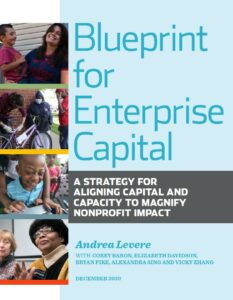Blueprint for Enterprise Capital: A Strategy for Aligning Capital & Capacity to Magnify Nonprofit Impact
By: Andrea Levere, with Corey Baron, Elizabeth Davidson, Bryan Fike, Alexandra Sing and Vicky Zhang
Published: December 2020
Meeting the Needs of This Moment
 Our nation is in crisis. The coronavirus pandemic has exposed the deep disparities in our society created by a confluence of factors—structural racism, wealth inequality, the disinvestment in public systems and the consequences of climate change. This crisis has shaken our economy to its foundation, revealing the breadth and depth of financial insecurity at the household level and increasing the ranks of the poor by millions. Our short-term economic future looks increasingly uncertain as the nation fails to meaningfully control the pandemic or provide the necessary federal stimulus funding to those most in need.
Our nation is in crisis. The coronavirus pandemic has exposed the deep disparities in our society created by a confluence of factors—structural racism, wealth inequality, the disinvestment in public systems and the consequences of climate change. This crisis has shaken our economy to its foundation, revealing the breadth and depth of financial insecurity at the household level and increasing the ranks of the poor by millions. Our short-term economic future looks increasingly uncertain as the nation fails to meaningfully control the pandemic or provide the necessary federal stimulus funding to those most in need.
This crisis has also revealed the role of nonprofits and social enterprises as major drivers of hope and change. Fundamentally, nonprofits operate as “small businesses” pursuing missions that give them a tax status different from for-profit enterprises. They employ 12.3 million people nationally, a number equal to 10% of the private workforce. The weaknesses of many of our public systems have elevated their stature as “essential workers” of our communities. These small- and mid-sized local enterprises have a long history of engineering community stabilization, fueling economic and health recovery, and building trust to bridge the deep divides that both cause and limit solutions to our problems. Independent Sector reports that as of October 2020 “…7% of nonprofits are estimated to close due to the pandemic and almost 1 million nonprofit jobs have been lost.”
Yet, in times of crisis, these organizations rarely garner the kind of public or corporate support that for-profit businesses receive. Gaps in public funding mirror how the “capital markets” that serve the nonprofit sector—a mix of institutional philanthropy, private donors, public agencies and corporate giving—often fail to provide funding in ways that deliver the greatest value. Overall, funders too often provide short-term, program-restricted grants, with larger foundations reporting that they target 72% of their grants for specific purposes rather than structuring capital in the ways that organizations need to build their financial strength and resilience.
Even in normal times, nonprofits scramble to raise capital across multiple fronts, resulting in differing requirements imposed by various capital sources that too often reflect the funder’s priorities rather than the nonprofit’s purpose. These funding practices fragment effort, distract from focus, and create complexity that requires management systems for which philanthropy rarely pays. In a sense, philanthropy has “reverse-engineered” these organizations to “chase the money” rather than providing capital flexible enough to fund their missions directly. But without the right capital— financial, social and human—these organizations cannot meet the challenges of this moment or of their missions.
This Blueprint for Enterprise Capital seeks to capitalize on this moment and build on the Call to Action to ensure that new types of capital and pathways to capital remain open permanently. It promotes an approach that advances change from the ground up, driven by the enterprises rooted in these communities.